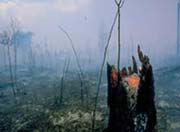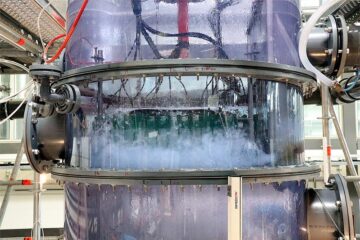Logging fuels fire

Logging made Borneo’s forests more susceptible to fire <br>© F. Siegert
Felling trees raises rainforests’ risk of burning.
Late last century, flames licked through the undergrowth of drought-dried rainforest in Indonesia. Over three months, the fire consumed an area half the size of Switzerland. Logging made the region susceptible to destruction, a study now finds.
Rainforests are normally wet and fireproof. Between 1997 and 1998 El Nino caused a drought that triggered rainforest fires worldwide. Recently-logged regions on the south-east Asian island of Borneo burnt more frequently and severely than virgin forest, Florian Siegert of Ludwig-Maximilians-University and colleagues have shown1.
When selective logging takes out a choice tree for timber, others are felled as it falls, leaving flammable wood on the ground. This, and road construction for timber transport, punch large holes in the forest’s dense canopy which let in the sun and dry out the scrub beneath.
Ground fires then „become much more destructive,“ says Seigert. Flames, usually only 1 or 2 metres high, reach up to 15 metres in logged areas. And one fire increases the risk of another by leaving partially burnt firewood in its wake.
Rainforest blazes are thought to start when fires used to clear land for grazing or plantations get out of control; over-logging exacerbates the problem. „Burning and logging on the same landscape is a recipe for disaster,“ agrees Michael Cochrane of the Basic Science and Remote Sensing Initiative in East Lansing, Michigan.
Changing land-use requires government initiatives, encouraging, for example, sustainable logging, in which a forest is allowed to recover between harvests. „It’s not an easy task,“ admits Cochrane. „If something’s not done these forests will be wiped out,“ he warns.
Fire screen
Rainforest fire damage can be difficult to detect. It is hidden beneath remaining vegetation and obscured by haze or smoke. Seigert’s team took satellite images of the scarred forest using radar sensors to penetrate the cloud and reveal forest structure and dampness. They compared the images to land-cover maps made before the fire.
The Borneo findings back earlier studies in the Amazonian rainforest showing that logging is a catalyst for fire. Accidental blazes have damaged nearly half of the remaining Amazon forest2. „Rainforest fires have emerged as one of the biggest environmental issues of the last decade,“ says ecologist Dan Nepstad of Woods Hole Research Center in Massachusetts.
The carbon released from large forest fires could negate the decreases in carbon emissions that the Kyoto Protocol demands, Nepstad points out. „[Fires] could easily counteract the reductions,“ he says, as well as threatening forest flora and fauna.
References
- Siegert, F., Ruecker, G., Hinrichs, A. & Hoffman, A. A. Increased damage from fires in logged forests during droughts caused by El Nino. Nature, 414, 437 – 440, (2001).
- Cochrane, M. et al. Positive feedbacks in the fire dynamics of closed canopy tropical forests. Science, 284, 1832 – 1835, (1999).
Media Contact
Weitere Informationen:
http://www.nature.com/nsu/011122/011122-12.htmlAlle Nachrichten aus der Kategorie: Ökologie Umwelt- Naturschutz
Dieser Themenkomplex befasst sich primär mit den Wechselbeziehungen zwischen Organismen und den auf sie wirkenden Umweltfaktoren, aber auch im weiteren Sinn zwischen einzelnen unbelebten Umweltfaktoren.
Der innovations report bietet Ihnen interessante Berichte und Artikel, unter anderem zu den Teilbereichen: Klimaschutz, Landschaftsschutzgebiete, Ökosysteme, Naturparks sowie zu Untersuchungen der Leistungsfähigkeit des Naturhaushaltes.
Neueste Beiträge

Experiment öffnet Tür für Millionen von Qubits auf einem Chip
Forschenden der Universität Basel und des NCCR SPIN ist es erstmals gelungen, eine kontrollierbare Wechselwirkung zwischen zwei Lochspin-Qubits in einem herkömmlichen Silizium-Transistor zu realisieren. Diese Entwicklung eröffnet die Möglichkeit, Millionen…

Stofftrennung trifft auf Energiewende
Trennkolonnen dienen der Separation von unterschiedlichsten Stoffgemischen in der chemischen Industrie. Die steigende Nutzung erneuerbarer Energiequellen bringt nun jedoch neue Anforderungen für einen flexibleren Betrieb mit sich. Im Projekt ColTray…

Kreuzfahrtschiff als Datensammler
Helmholtz-Innovationsplattform und HX Hurtigruten Expeditions erproben neue Wege in der Ozeanbeobachtung. Wissenschaftliche Forschung nicht nur von speziellen Forschungsschiffen aus zu betreiben, sondern auch von nicht-wissenschaftlichen Schiffen und marinen Infrastrukturen –…





















